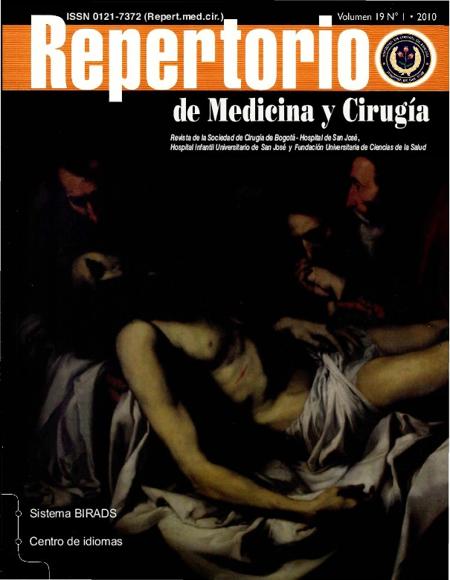Doppler fetoplacentario en hipertensión gestacional y preeclampsia leve
Fetoplacental Doppler in gestational hypertension and mild preeclampsia
Esta obra está bajo una licencia internacional Creative Commons Atribución-NoComercial-CompartirIgual 4.0.
Mostrar biografía de los autores
Introducción: la preeclampsia se presenta en 6% de los embarazos en Colombia y se asocia con una elevada tasa de morbimortalidad maternofetal. Con frecuencia los casos severos se acompañan de restricción del crecimiento intrauterino; en estos casos el doppler fetoplacentario es útil para determinar el pronóstico fetal, pero su valor en preeclampsia leve o hipertensión gestacional no está bien definido. Objetivos: determinar en estas dos circunstancias la frecuencia de alteraciones en el doppler de las arterias umbilical y cerebral media. Materiales y métodos: búsqueda de casos en la base datos de la unidad de medicina maternofetal del Hospital de San José, entre agosto de 2006 y febrero de 2008. Se definió como casos las pacientes con gestaciones > a 28 semanas con HTG o PL y fetos con perfil de crecimiento normal. Se consideraron y analizaron variables demográficas, resultados del doppler fetoplacentario y las complicaciones. Resultados: se identificaron 85 pacientes. El 17% presentó alteración del doppler de la AU y 7% de la ACM; en gestaciones < 32 semanas los hallazgos anormales son bajos (75% AU y 85% ACM normales). Conclusiones: la frecuencia de alteraciones en el Doppler de AU y ACM fue similar en el grupo de mujeres que presentaron complicaciones y aquellas con un desenlace normal. Abreviaturas: RCIU, restricción del crecimiento intrauterino; PL, preclampsia leve; HTG, hipertensión gestacional; AU, arteria umbilical; ACM, arteria cerebral media.
Visitas del artículo 357 | Visitas PDF 2077
Descargas
1. López-Jaramillo P. Bioquímica del endotelio vascular: implicaciones fisiológicas y clínicas. 5a ed. Bogotá: Horizonte impresores; 2001.
2. Norwitz ER. Implantation and the survival of early pregnancy. N Eng J Med. 2001;59(6):1400-18.
3. Spectral Doppler sonography, wave form analysis and hemodynamic interpretation. In: Maulik D, editor. Doppler ultrasound in obstetrics and gynecology. New York: Springer Verlag; 1997. p. 55.
4. Pridjian G, Puschett JB. Clinical and pathophysiologic considerations of preeclampsia. Obs Gynecol Surv. 2002; 57(9):598-618.
5. Walker JJ. Preeclampsia. Lancet. 2000 ;356(9237):1260-5.
6. Pridjian G, Puschett JB. Preeclampsia part 2: experimental and genetic considerations. Obstet Gynecol Surv. 2002; 57(9): 619-40.
7. Wilson ML, Goodwin TM, Pan VL, Ingles SA. Molecular epidemiology of preeclampsia. Obst Gynecol Surv. 2002; 58(1):1158-68.
8. Page NM. The endocrinology of pre-eclampsia. Clin Endocrinol (Oxf). 2002; 57(4):413-23.
9. Gillham JC. An overview of endothelium-derived hyperpolarising factor (EDHF) in normal and compromised pregnancies. Eur J Obst Gynecol Rep Biol. 2003;109:2-7.
10. Arslan M. Endothelin-1 and leptin in the pathophysiology of intrauterine growth restriction. Int J Gynaecol Obstet. 2004; 84(2):120-6.
11. Balat O, Aksoy F, Kutlar I, Ugur MG, Iyikosker H, Balat A, et al. Increased plasma levels of urotensin-II in preeclampsiaeclampsia: a new mediator in pathogenesis?. Eur J Obstet Gynecol Reprod Biol. 2005; 120(1):33-8.
12. López-Jaramillo P, Terán E, de Félix M, Villacres M, Barba L, Moya W. Papel del óxido nítrico durante el embarazo normal y la preeclampsia. Rev Colomb Cardiol. 1998; 6:169-76.
13. Chervenak F, Kurjak A. The clinical care of the fetus as a patient. In: Kurjak A, Chervenak F, editors. The fetus as a patient. London: The Parthenon Publishing Group, 1994.
14. Merivel P. Physiopatology of pre-eclampsia and intrauterine growth restriction. In: Kurjak A, Chervenak F, editors. The fetus as a patient. London: The Parthenon Publishing Group, 1994. 347-55.
15. Dash PR, Cartwright JE, Baker PN, Johnstone AP, Whitley GS. Nitric oxide protects human extravillous trophoblast cells from apoptosis B a cyclic GMP-dependent mechanism and independently of caspase 3 nitrosylation. Exp Cell Res. 2003; 287(2):314-24.
16. Neilson JP, Alfirevic Z. Doppler ultrasound for fetal assessment in high risk pregnancies. Cochrane Database Syst Rev. 2010 Jan; (1): CD000073.
17. Papagergeorghiou AT. Predicting and preventing preeclampsia where to next?. Ultrasound Obstet Gynecol. 2008;31(4): 370- 6.
18. Moldenhauer JS, Stanek J, Warshak C, Khoury J, Sibai B. The frequency and severity of placental findings in women with preeclampsia are gestational age dependent. Am J Obstet Gynecol. 2003; 189(4):1173-7.
19. Ness RB, Roberts JM. Heterogeneous causes constituting the single syndrome of preeclampsia: a hypotesis and its implications. Am J Obstet Gynecol. 1996; 175:1365-70.
20. Aardema MW, Saro MC, Lander M, De Wolf BT, Oosterhof H, Aarnoudse JG. Second trimester Doppler ultrasound screening of the uterine arteries differentiates between subsequent normal and poor outcomes of hypertensive pregnancy: two different pathophysiological entities?. Clin Sci. (London) 2004; 106: 377-82.
21. Bricker L, Neilson JP, Dowswell T.. Routine ultrasound in late pregnancy (after 24 weeks gestation). Cochrane Database Syst Rev. 2008 Oct 8;(4):CD001451
22. Vatten LJ, Skjaerven R. Is pre-eclampsia more than one disease? BJOG. 2004; 111(4):298-302.
23. von Dadelszen P, Magee LA, Roberts JM. Subclassification of preeclampsia. Hypertens Pregnancy. 2003; 22(2):143-8.













